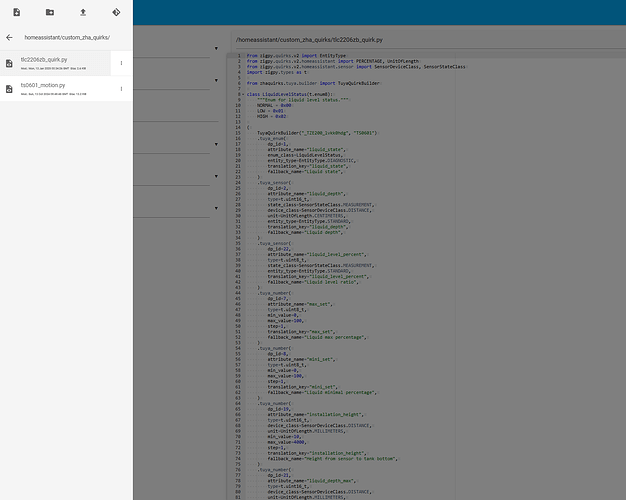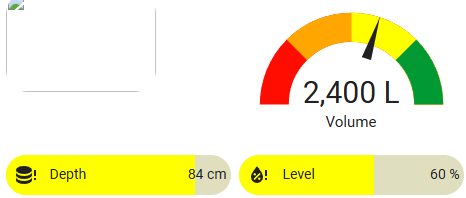I have purchased several ultrasonic sensors TZE200_lvkk0hdg
Those are absolutely great sensors and very useful in household and garden, to be used both for water storage tanks, drainage tanks, swimming pool levels etc…
Unfortunatelly I have managed to pair them just with TUYA app on my phone, byt even local tuya cant see levels in HA.
I have tried to make a custom quirk for it but it doesnt work:
"""Custom quirk for EPTTECH TLC2206-ZB Tank Level Sensor."""
from zigpy.profiles import zha
from zigpy.quirks import CustomDevice
from zigpy.zcl.clusters.general import Basic, Groups, Scenes, Ota, Time
from zigpy.zcl.clusters.measurement import FlowMeasurement
from zhaquirks.const import (
DEVICE_TYPE,
ENDPOINTS,
INPUT_CLUSTERS,
MODELS_INFO,
OUTPUT_CLUSTERS,
PROFILE_ID,
)
from zhaquirks.tuya import TuyaLocalCluster
from zhaquirks.tuya.mcu import DPToAttributeMapping, TuyaMCUCluster
import zigpy.types as t
# Define the data points (DPs) for the sensor
TUYA_TANK_LEVEL_PERCENT_DP = 22
TUYA_TANK_DEPTH_DP = 2
TUYA_TANK_STATE_DP = 1
TUYA_INSTALLATION_HEIGHT_DP = 19
TUYA_MAX_SET_DP = 7
TUYA_MIN_SET_DP = 8
TUYA_DEPTH_MAX_DP = 21
class LiquidLevelStatus(t.enum8):
"""Enum for liquid level status."""
NORMAL = 0x00
LOW = 0x01
HIGH = 0x02
class TuyaTankLevelMeasurement(TuyaLocalCluster):
"""Custom cluster for tank level measurement."""
cluster_id = FlowMeasurement.cluster_id
name = "Tank Level Measurement"
ep_attribute = "liquid_level_measurement"
attributes = {
0x0000: ("measured_value", t.uint16_t, True),
0x0001: ("min_measured_value", t.uint16_t, True),
0x0002: ("max_measured_value", t.uint16_t, True),
0xFF00: ("liquid_level_percent", t.uint8_t, True),
0xFF01: ("liquid_depth", t.uint16_t, True), # Assuming depth is in mm
0xFF02: ("liquid_state", LiquidLevelStatus, True),
0xFF03: ("installation_height", t.uint16_t, True), # mm
0xFF04: ("max_set", t.uint8_t, True), # Percentage
0xFF05: ("mini_set", t.uint8_t, True), # Percentage
0xFF06: ("liquid_depth_max", t.uint16_t, True), # mm
}
class TuyaTankLevelCluster(TuyaMCUCluster):
"""Custom cluster for handling EPTTECH TLC2206-ZB tank level sensor data points."""
dp_to_attribute: dict[int, DPToAttributeMapping] = {
TUYA_TANK_LEVEL_PERCENT_DP: DPToAttributeMapping(
TuyaTankLevelMeasurement.ep_attribute,
"liquid_level_percent",
),
TUYA_TANK_DEPTH_DP: DPToAttributeMapping(
TuyaTankLevelMeasurement.ep_attribute,
"liquid_depth",
converter=lambda x: x / 100, # Convert mm to meters
),
TUYA_TANK_STATE_DP: DPToAttributeMapping(
TuyaTankLevelMeasurement.ep_attribute,
"liquid_state",
converter=lambda x: LiquidLevelStatus(x),
),
TUYA_INSTALLATION_HEIGHT_DP: DPToAttributeMapping(
TuyaTankLevelMeasurement.ep_attribute,
"installation_height",
),
TUYA_MAX_SET_DP: DPToAttributeMapping(
TuyaTankLevelMeasurement.ep_attribute,
"max_set",
),
TUYA_MIN_SET_DP: DPToAttributeMapping(
TuyaTankLevelMeasurement.ep_attribute,
"mini_set",
),
TUYA_DEPTH_MAX_DP: DPToAttributeMapping(
TuyaTankLevelMeasurement.ep_attribute,
"liquid_depth_max",
),
}
data_point_handlers = {
TUYA_TANK_LEVEL_PERCENT_DP: "_dp_2_attr_update",
TUYA_TANK_DEPTH_DP: "_dp_2_attr_update",
TUYA_TANK_STATE_DP: "_dp_2_attr_update",
TUYA_INSTALLATION_HEIGHT_DP: "_dp_2_attr_update",
TUYA_MAX_SET_DP: "_dp_2_attr_update",
TUYA_MIN_SET_DP: "_dp_2_attr_update",
TUYA_DEPTH_MAX_DP: "_dp_2_attr_update",
}
class EPTTECH_TLC2206ZB(CustomDevice):
"""Custom quirk for EPTTECH TLC2206-ZB Tank Level Sensor."""
signature = {
MODELS_INFO: [("TS0601", "_TZE200_lvkk0hdg")],
ENDPOINTS: {
1: {
PROFILE_ID: zha.PROFILE_ID,
DEVICE_TYPE: zha.DeviceType.IAS_ZONE, # Device type commonly used for sensors
INPUT_CLUSTERS: [
Basic.cluster_id,
TuyaTankLevelCluster.cluster_id, # Custom cluster for tank level
],
OUTPUT_CLUSTERS: [
Ota.cluster_id,
Time.cluster_id,
],
},
},
}
replacement = {
ENDPOINTS: {
1: {
PROFILE_ID: zha.PROFILE_ID,
DEVICE_TYPE: zha.DeviceType.IAS_ZONE,
INPUT_CLUSTERS: [
Basic.cluster_id,
TuyaTankLevelCluster, # Custom cluster for tank level
],
OUTPUT_CLUSTERS: [
Ota.cluster_id,
Time.cluster_id,
],
},
},
}
Could ZHA development team add support for the device like mqtt2zigbee did?


